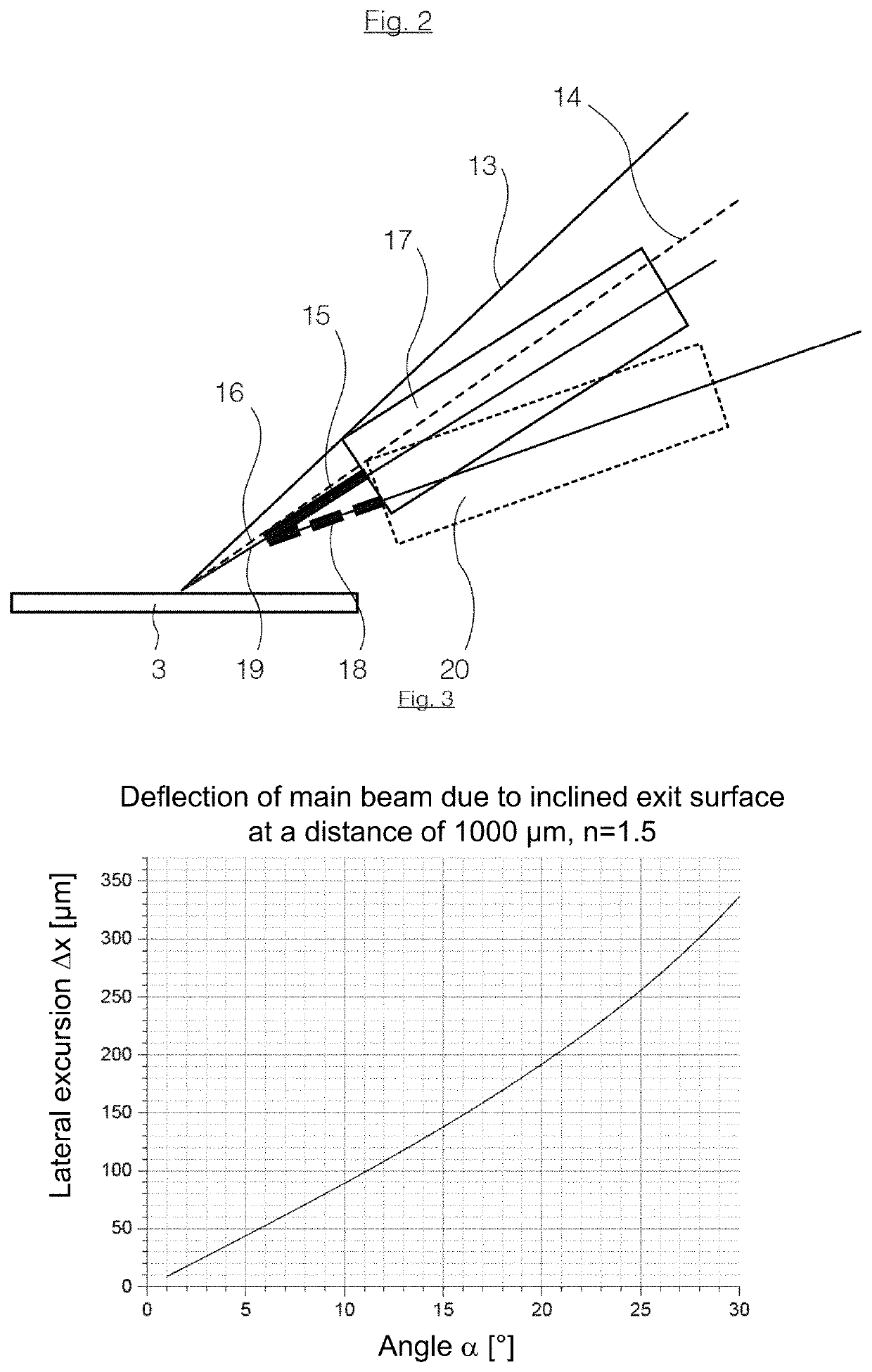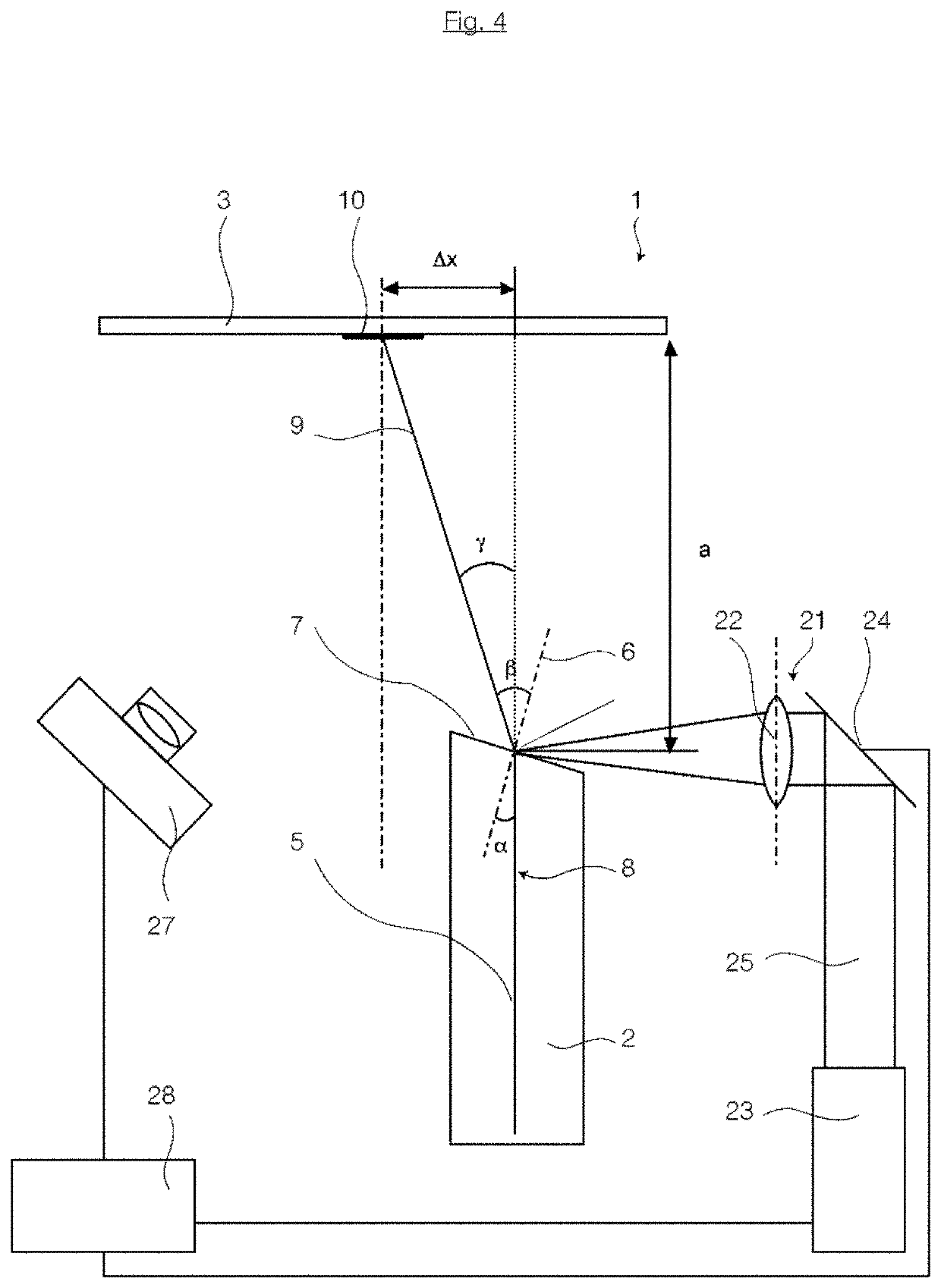Method for aligning a light spot produced on an optical converter, device comprising a light spot and use thereof, and converter-cooling body assembly with metallic solder connection
a technology of optical converters and light spots, which is applied in the direction of lighting and heating apparatus, lighting heating/cooling arrangements, projectors, etc., can solve the problems of material usually acting uncritically, defects can occur, and the light exit head comprising the optical fiber or the light guide can be easily removed and replaced, etc., to achieve good radial alignment and positioning of the light guiding fiber, different optical properties, and narrow tolerances
- Summary
- Abstract
- Description
- Claims
- Application Information
AI Technical Summary
Benefits of technology
Problems solved by technology
Method used
Image
Examples
first embodiment
[0178]Referring now to FIG. 9, which shows a perspective schematic view, viewed obliquely from above, of a fiber-optical light exit head 30 of a fiber-optic conversion module 1 according to a
[0179]The optical converter 3, and the holder 29 for fiber 4 with the fiber 4 arranged therein can be seen underneath a protective cover made of glass 31 which is arranged as an elongated sleeve in a monolithic body 32 which carries both the fiber 4 with its holder 29 and the optical converter 3.
[0180]Monolithic body 32 also supports a light trap 33 which has a plug-like element 34 at its end, which can be seen in FIG. 9 and will be described below in more detail with reference to FIG. 11.
[0181]By means of a sleeve 35 that is arranged in monolithic body 32, the fiber 4 can be held in a mechanically reliably manner on light exit head 30.
[0182]A fitting feature in the form of a rectangular recess 36 is provided on the lower face of monolithic body 32, which together with bevels 37, 38, and 39 of d...
second embodiment
[0199]Referring now to FIG. 12, which is a perspective schematic view obliquely from above, illustrating the light exit head 30 of a fiber-optic conversion module 1 of a second embodiment, with useful light 11 exiting therefrom.
[0200]This figure shows clearly that the cone of useful light 11 can extend as far as to the holder 20 of fiber 4, or 18, and that the advantage of reduced shading of useful light already described with reference to FIG. 2 is provided by virtue of the inclined exit surface 7.
[0201]A further advantage of this embodiment can also be seen from FIG. 13, which is a perspective schematic view, obliquely from above, of the monolithic body 32 of light exit head 30 of fiber-optic conversion module 1 of the second embodiment shown in FIG. 12, but without the fiber being held therein or thereon and without the optical converter being held thereon.
[0202]In this embodiment, the monolithic body 32 has two substantially planar lateral surfaces 46, 47 and can be produced as ...
third embodiment
[0206]FIG. 17 shows a perspective view, obliquely from above, of the light exit head 30 of a fiber-optic conversion module 1 of a
[0207]In this embodiment, the protective cover made of glass 31 is of tubular design, with a closed rounded end and an open end, and extends over more than half of the length of monolithic body 32.
[0208]Thus, a lamp bulb-like configuration is obtained, which allows the light exit head 30 to be inserted in reflectors along its longitudinal extension, which reflectors preferably include further light-guiding elements, such as deflecting mirrors, in order to be able to exploit the emitted useful light the most completely possible.
[0209]For holding the light exit head of this embodiment in a mechanically exact manner, mating surfaces 58 and 59 are provided, mating surface 59 cooperating with a further mating surface 60 (not shown in this figure), with which it forms an approximately V-shaped arrangement.
[0210]Furthermore, accurately fitting inclined surfaces 6...
PUM
| Property | Measurement | Unit |
|---|---|---|
| inclination angles | aaaaa | aaaaa |
| size | aaaaa | aaaaa |
| size | aaaaa | aaaaa |
Abstract
Description
Claims
Application Information
 Login to View More
Login to View More - R&D
- Intellectual Property
- Life Sciences
- Materials
- Tech Scout
- Unparalleled Data Quality
- Higher Quality Content
- 60% Fewer Hallucinations
Browse by: Latest US Patents, China's latest patents, Technical Efficacy Thesaurus, Application Domain, Technology Topic, Popular Technical Reports.
© 2025 PatSnap. All rights reserved.Legal|Privacy policy|Modern Slavery Act Transparency Statement|Sitemap|About US| Contact US: help@patsnap.com



